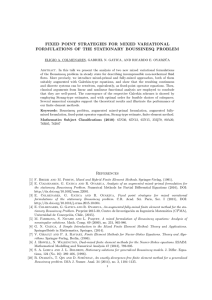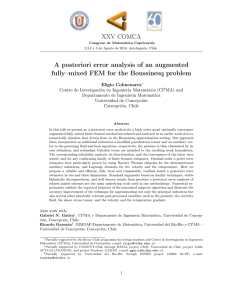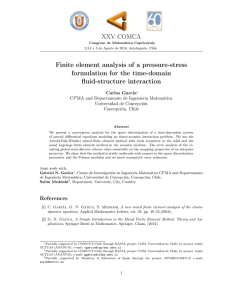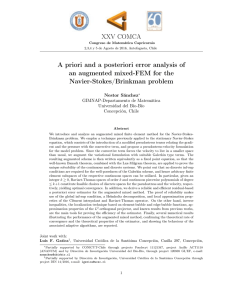LA SERENA NUMERICA II Mixed
Anuncio
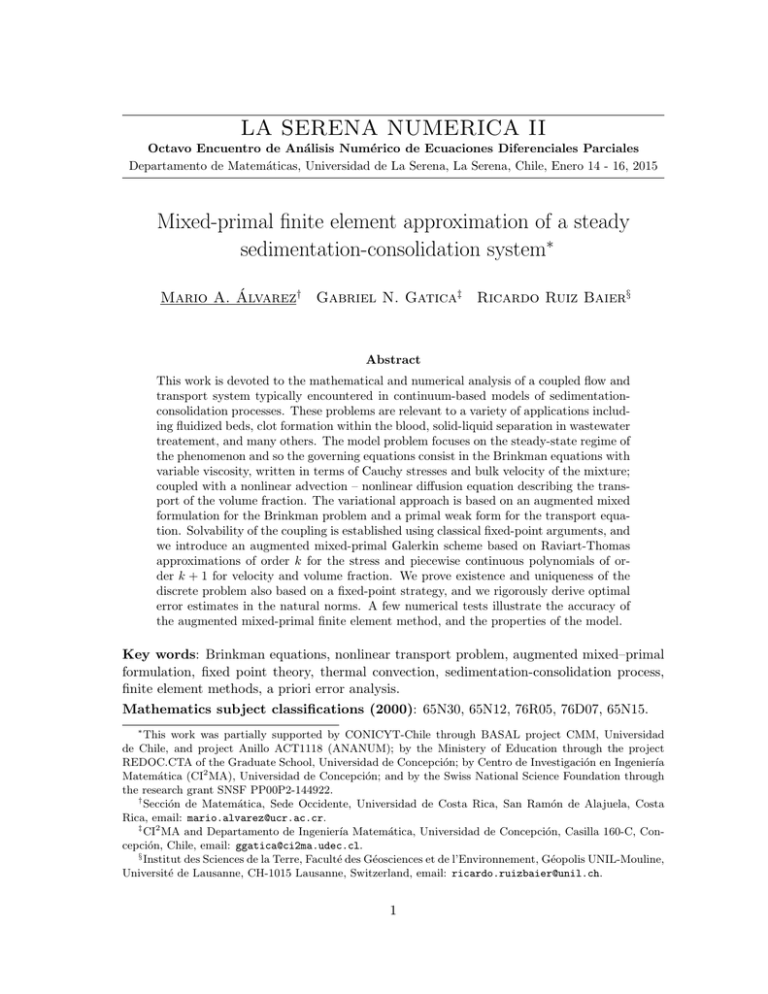
LA SERENA NUMERICA II Octavo Encuentro de Análisis Numérico de Ecuaciones Diferenciales Parciales Departamento de Matemáticas, Universidad de La Serena, La Serena, Chile, Enero 14 - 16, 2015 Mixed-primal finite element approximation of a steady sedimentation-consolidation system∗ Mario A. Álvarez† Gabriel N. Gatica‡ Ricardo Ruiz Baier§ Abstract This work is devoted to the mathematical and numerical analysis of a coupled flow and transport system typically encountered in continuum-based models of sedimentationconsolidation processes. These problems are relevant to a variety of applications including fluidized beds, clot formation within the blood, solid-liquid separation in wastewater treatement, and many others. The model problem focuses on the steady-state regime of the phenomenon and so the governing equations consist in the Brinkman equations with variable viscosity, written in terms of Cauchy stresses and bulk velocity of the mixture; coupled with a nonlinear advection – nonlinear diffusion equation describing the transport of the volume fraction. The variational approach is based on an augmented mixed formulation for the Brinkman problem and a primal weak form for the transport equation. Solvability of the coupling is established using classical fixed-point arguments, and we introduce an augmented mixed-primal Galerkin scheme based on Raviart-Thomas approximations of order k for the stress and piecewise continuous polynomials of order k + 1 for velocity and volume fraction. We prove existence and uniqueness of the discrete problem also based on a fixed-point strategy, and we rigorously derive optimal error estimates in the natural norms. A few numerical tests illustrate the accuracy of the augmented mixed-primal finite element method, and the properties of the model. Key words: Brinkman equations, nonlinear transport problem, augmented mixed–primal formulation, fixed point theory, thermal convection, sedimentation-consolidation process, finite element methods, a priori error analysis. Mathematics subject classifications (2000): 65N30, 65N12, 76R05, 76D07, 65N15. ∗ This work was partially supported by CONICYT-Chile through BASAL project CMM, Universidad de Chile, and project Anillo ACT1118 (ANANUM); by the Ministery of Education through the project REDOC.CTA of the Graduate School, Universidad de Concepción; by Centro de Investigación en Ingenierı́a Matemática (CI2 MA), Universidad de Concepción; and by the Swiss National Science Foundation through the research grant SNSF PP00P2-144922. † Sección de Matemática, Sede Occidente, Universidad de Costa Rica, San Ramón de Alajuela, Costa Rica, email: mario.alvarez@ucr.ac.cr. ‡ CI2 MA and Departamento de Ingenierı́a Matemática, Universidad de Concepción, Casilla 160-C, Concepción, Chile, email: ggatica@ci2ma.udec.cl. § Institut des Sciences de la Terre, Faculté des Géosciences et de l’Environnement, Géopolis UNIL-Mouline, Université de Lausanne, CH-1015 Lausanne, Switzerland, email: ricardo.ruizbaier@unil.ch. 1 References [1] M.A. Álvarez, G.N. Gatica, and R. Ruiz-Baier, An augmented mixed–primal finite element method for a coupled flow–transport problem. Preprint 2014–24, Centro de Investigación en Ingenierı́a Matemática (CI2 MA), Universidad de Concepción, (2014) [available from http://www.ci2ma.udec.cl] [2] R. Bürger, S. Kumar, and R. Ruiz-Baier, Discontinuous finite volume element discretization for coupled flow-transport problems arising in models of sedimentation. Preprint 2014–25, Centro de Investigación en Ingenierı́a Matemática (CI2 MA), Universidad de Concepción, (2014) [available from http://www.ci2ma.udec.cl] [3] R. Bürger, W.L. Wendland and F. Concha, Model equations for gravitational sedimentation-consolidation processes. ZAMM Z. Angew. Math. Mech. 80 (2000), no. 2, 79–92. [4] L.E. Figueroa, G.N. Gatica and A. Márquez, Augmented mixed finite element methods for the stationary Stokes equations. SIAM J. Sci. Comput. 31 (2008/09), no. 2, 1082–1119. [5] G.N. Gatica, A Simple Introduction to the Mixed Finite Element Method: Theory and Applications. Springer Briefs in Mathematics. Springer, Cham, 2014. 2
